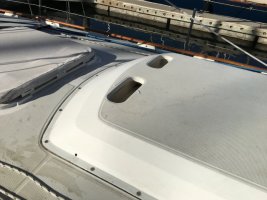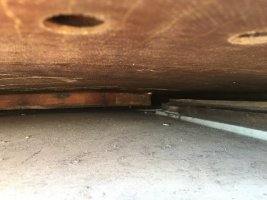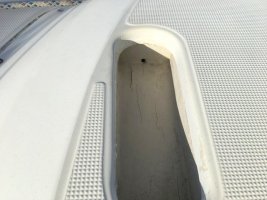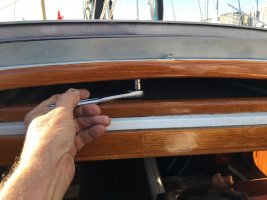
The Ericson sea hood covers the hatch over the companionway when the hatch is open. Such a hood is the easiest way to prevent water from entering the forward end of a sliding hatch, and to protect it from feet, lines and other abuse when open.
The hood is made of plywood sandwiched between fiberglass, with gelcoat non-skid top.

Transverse piece is hatch stopper. Overhead has cutouts for traveler nuts.
The sliding hatch rides on rails--teak stringers topped by aluminum--that extend from the companionway to about 3/4th of the way through the sea hood body. At that point, a teak rail is installed as a hatch stopper.
The sea hood is a marvel of construction which has to meet the compound lines of the deck, be strong enough to stand on without deflecting onto the acrylic hatch, and look good, which it does.
The forward quarter of the hood exists to provide two storage pockets. Their use is either for winch handles (on early models, when halyard winches were mounted on deck at the mast base), or sail-tie storage, or beer cans, or just to make you crazy.
The pockets, which do not connect to the deck roof below, were built of wood that is exposed to the elements. They tend to hold water if the drain holes are clogged.
The photo below shows a pocket in need of periodic maintenance. It has been painted in the past, and just needs a sanding and a few new coats of Brightside. They don't leak and the wood is sound.

The pocket drain holes admit water under the hood. There is no tube or channel.
Water that drains under the hood is contained outside the sliding hatch rails underneath. It can't get into the companionway or the boat. It exits the hood through three hood drains on either side.
Maintenance therefore amounts to periodic cleaning out of all drain holes and preserving the wood of the pockets, if they haven't yet rotted out.
If they have, members tend to glass them over.
Removal of the sea hood requires pulling the big screws surrounding it and breaking the caulk bond.
The traveler channel, if there is one, is attached to the sea hood by about 10 of the 20 machine screws which secure the traveler track to it.
If the channel can be left on the sea hood, they can come off together. The bolts for the channel ends are accessible through cabin headliner zippers.
Removing the traveler track from the channel, however, means removing nuts on the machine screws that penetrate the channel.
If the sliding hatch can be removed, a socket wrench will fit under the hood and removal of nuts is easy.

If the sliding hatch cannot be removed, members have devised a special low-profile tool to do the job.

Note: The traveler track and its channel are aluminum. The 20 quarter-inch bolts that pass through both are stainless steel. It is very likely that after 30-plus years corrosion bonding between the dissimilar metals has occurred, making separation--what is the right word? "Nightmare" comes close.
Related threads:
https://www.ericsonyachts.org/infoexchange/entry.php?583-Ericson-38-Ronstan-Traveler-Upgrade
http://www.ericsonyachts.org/infoex...Removal-or-not&p=110938&viewfull=1#post110938
http://www.ericsonyachts.org/infoex...-Traveller-Upgrade-do-I-take-the-sea-hood-off
Last edited:
